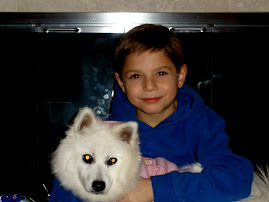January 18, 2009
Once your dog has learned the “Sit” command. Natural progression tells you to teach him to “Stay”. This command is extremely useful in many circumstances, including preventing your dog from getting into all kinds of trouble. According to Dr. Rolan Tripp, D.V.M, some compelling reasons for you to teach your dog this command include:
· Giving your dog good street manners, such as stopping and sitting at curbs;
· Keeping him from begging by putting him in a “sit-stay” or “down-stay” during meals;
· Subduing aggression by putting him in a “down-stay” any time he acts dominant;
· Keeping him out of harm’s way in an emergency, if you suddenly have to turn your attention elsewhere.
Other examples are when at home someone rings the doorbell and you let visitors into your home, or outdoors when your dog might want to chase something it is interested in.
Ok, now that you’re convinced that you need to teach your dog the “Stay” command, here’s how:
First, ask your dog to sit in front of you. Then, place your open hand in front of your dog’s face as if you are telling him to stop, but instead give the command, “Stay”. Count to 3 and then reward your dog with praise and a treat. Repeat this process while slowing increasing the amount of time you wait before praising your dog.
Once your dog can hold a Stay while you count to ten, then increase the difficulty by taking a few steps backward. If your dog continues to successfully hold the “sit”, then continue to slowly increase the difficulty by stepping further away. However, during this phase of the training, do not let your dog’s sight. This will come in Part 2, to follow soon.
Other Helpful tips:
- Don’t teach too much at one time and overload your dog. On the first day, practice with your dog for just 5 – 10 minutes. Make sure that your dog is having fun, and you should be having fun, too. If your dog is not having fun, you should end the exercise and try again at another time.
- As always, end every session on a positive note.
- Practice this command often – even if you feel your dog has fully mastered it.
- Eventually try to phase out the food reward in exchange for lavish praise.
- Gently praise your dog periodically during the stay to let him know he's on the right track. If you just reprimand him for breaking the stay, he won't want to follow the command. If you praise him two or three times before he breaks the stay and only reprimand after breaking it, he'll learn that staying is good and breaking the stay is bad. And that's exactly what you want him to think.
- Use reprimands only after your dog can hold the Stay for at least 30 seconds.
- Pay attention to your dog. You never want to set your dog up for failure. If you don’t pay attention while your dog is staying, he won’t pay attention to your command. Watch for signs that he is ready to break the Stay and cut the exercise short, if necessary. Your focus should be on rewarding your dog for good responses, not punishing him for mistakes.
- Don’t use the stay command more than 5 times per day. For training to be effective it needs to be fun for your dog – don’t abuse your power.
Check back for the next blog entry in this series: TEACHING BASIC COMMANDS - ("STAY") – Part 2.
skip to main |
skip to sidebar

Geisha, Sami, and Ju-Ju (waiting for a treat)



(7 weeks old)

(7 weeks old)






"Psssst . . . I need to tell you a secret . . . "
This blog is created by and for Japanese Spitz lovers. Sweet Samurai is a small, home-based kennel in TN. We have three JS & created this blog to help provide continual support to our friends who purchase our grandpuppies, as well as anyone who owns/loves JS. If you would like information regarding our dogs, please visit our website at www.sweetsamurai.com or e-mail us at SweetSamuraiKennels@gmail.com. To receive this blog via e-mail, type your address in the subscription field below.
Search This Blog
E-MAIL SUBSCRIPTIONS
Our Three Babies

Geisha, Sami, and Ju-Ju (waiting for a treat)
Blog Archive
-
►
2008
(12)
- ► November 2008 (8)
- ► December 2008 (4)
-
▼
2009
(57)
- ▼ January 2009 (5)
- ► February 2009 (1)
- ► March 2009 (4)
- ► April 2009 (1)
- ► August 2009 (8)
- ► September 2009 (7)
- ► October 2009 (5)
- ► November 2009 (7)
- ► December 2009 (5)
-
►
2010
(36)
- ► January 2010 (10)
- ► February 2010 (8)
- ► March 2010 (3)
- ► August 2010 (2)
- ► October 2010 (3)
-
►
2011
(25)
- ► February 2011 (1)
- ► March 2011 (4)
- ► April 2011 (3)
- ► August 2011 (3)
Past Blog Entries - ASPCA tips
Past Blog Entries - Teaching Basic Commands
Past Blog Entries - First Aid in the Field
Past Blog Entries - Caring For Your Senior
Past Blog Entries - Cooking For Canines
Past Blog Entries - Indoor Brain Games
Past Blog Entries - Treat Recipes for your Dog
Geisha & Sami (January, 2008)

Ju-Ju (12 weeks old)

Sasuke (from our first litter)

(7 weeks old)
Izzy and Yuki (from our first litter)

(7 weeks old)
Other Interesting Links
- American Rare Breed Association
- American Society for the Provention of Cruelty to Animals
- Best Friends Animal Society
- Dogpile.com - a search engine that helps rescue pets
- Japanese Spitz Club of America
- Pet Food Recalls
- Pet Products Containing Lead
- Sweet Samurai Kennels Official Website
- Sweet Samurai Videos
- The Japanese Spitz (according to Pedigree.com)
- The Japanese Spitz Kennel Club Book
- United Kennel Club
- Yoshi (A grandpuppy from our May, 2008 litter)
Recommended References and Reading
- Japanese Spitz Kennel Club Book by Michael Rule
- The Japanese Spitz by Marco G. Piasentin
- Vet Confidential; An Insider's Guide to Protecting your Pet's Health by Louise Murray, D.V.M.
- First Aid for Dogs; What to do When Emergencies Happen by Bruce Fogle, D.V.M.
- Marley and Me: Life and Love with the World's Worst Dog by John Grogan
Ju-Ju and Sami

Reputable U.S. Japanese Spitz Breeders
Little Ju-Ju

Izzy (a puppy from our May, 2008 litter)

Kona (puppy from May, 2008 litter)
Ju-Ju (January, 2009)


"Psssst . . . I need to tell you a secret . . . "
Site Disclaimer: The information contained in this site is general in nature and has been researched and compiled from a variety of sources. It is not a substitute for professional veterinary care, and is not meant to replace the advice of veterinary care professionals. If you have specific veterinary needs, or for complete information about your dog(s), please see a veterinarian. Readers of this blog agree that neither Sweet Samurai Kennels, nor its owners have any liability with respect to any actions taken as a result of or in connection with viewing any information contained on this site. You agree to use this site and the information presented at your own risk. Some areas of our site may provide links to other external sites that we don't own, control or influence. We reference sites that we think might be useful or of interest to you, but we are not responsible for the content or privacy practices used by other site owners. Information contained in the external sites is not endorsed by Sweet Samurai Kennels, nor its owners. It is simply offered as a service to our visitors.


